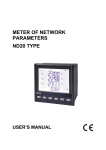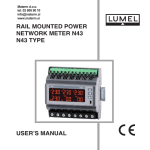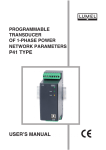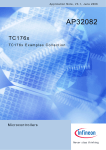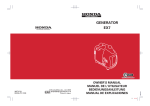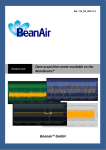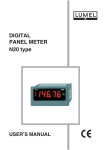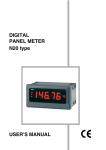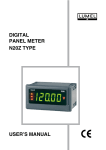Download METER OF NETWORK PARAMETERS ND10 TYPE USER'S MANUAL
Transcript
METER OF NETWORK PARAMETERS ND10 TYPE USER’S MANUAL 1 Contents 1. APPLICATION ................................................................... 3 2. METER SET ...................................................................... 3 3. BASIC REQUIREMENTS AND OPERATIONAL SAFETY ..................... 3 4. INSTALLATION .................................................................. 3 5. METER DESCRIPTION .......................................................... 4 6. ND10 METER PROGRAMMING ................................................ 7 7. SOFTWARE UPGRADE......................................................... 16 8. RS-485 INTERFACE ............................................................ 17 9. ERROR CODES ................................................................. 24 10. TECHNICAL DATA .............................................................. 24 11. ORDERING CODES ............................................................. 28 3 N D1 0- 09 / 1 Use r 's m a nua l 3 1 APPLICATION The ND10 meter is a digital programmable panel meter destined for the measurement of the 3phase, 4-wire power network parameters in balanced and unbalanced systems. It is also capable of displaying measured quantities and their simultaneous digital transmission. The meter is also capable of controlling and optimization of the power electronic devices, systems, and industrial installations. The meter can be used for measuring: RMS value of voltage and current; active, reactive and apparent power; active and reactive energy, power parameters; frequency, 15-, 30- and 60-minute mean active power and THD. Additionally, a current in the neutral wire is calculated from the phase current vectors . Voltage and current values are multiplied by given voltage and current ratios of measuring transformers. Power and energy indications take into account all programmed ratio values. Any and all measured values can be sent to the master via the RS-485 interface. The relay outputs signal alarm when selected parameters exceed set limits. Impulse output can be used for consumption check of the 3-phase real energy. This meter is also able to detect and signal incorrect phase sequence. The meter is powered by the measuring circuit, i.e. from the voltage output. There is a galvanic separation between following units of the meter: - voltage and current inputs, - RS-485 output, - impulse output. 2 METER SET Complete set of the meter includes: - ND10 Meter - user's manual - warranty card - seal - panel mounting bracket 1 pcs. 1 pcs. 1 pcs. 1 pcs. 4 pcs. 3 BASIC REQUIREMENTS, OPERATIONAL SAFETY ND10 Meter fully conforms with the requirements of EN 61010-1 standard. Additional comments concerning safety: • The meter should be installed and connected only by a qualified personnel. All relevant safety measures should be observed during installation. • Always check the connections before turning the meter on. • Removal of the meter housing during the warranty period voids the warranty. • This meter conforms to all requirements of the electromagnetic compatibility in the industrial environment. • Building power network should include switch or automatic circuit breaker positioned in the convenient vicinity of the meter. It should be properly marked and available to operator at all times. 4 INSTALLATION ND10 Meter is adapted to be mounted to the panel with mounting brackets (see Fig. 1). Meter housing is made of plastic. Housing dimensions: 96 x 96 x 77 mm. On the outer side of the meter there are screw and tab terminal strips that can be used for connecting external wires with diameter up to 2.5 mm2. Prior to installation a 92,5+0.6 x 92,5+0.6 mm slot must be made in the panel. The thickness of the panel material should not exceed 15 mm. The meter must be placed in the panel from the front. During installation the powering voltage must be off. When the panel is inserted in the slot, mount it in place with provided mounting brackets. ND 10- 09 / 1 Us er 's m anua l 1 4 2 Fig. 1. Meter fitting Fig. 2. Meter dimensions 5 METER DESCRIPTION 5.1 Current in puts All current inputs are galvanically isolated (internal current transformers). The meter is suited to operate together with external measuring current transformers. Displayed values of currents as well as their derivative values are automatically calculated using set ratio value of the external transformer. Current inputs are specified in the order as either 1 A or 5 A. 5.2 Voltage inputs Displayed values of voltages as well as their derivative values are automatically calculated using set ratio value of the external transformer. Voltage inputs are specified in the order as either 3 x 57.7/100 V, 3 x 230/400 V or 3 x 290/500 V. N D1 0- 09 / 1 Use r 's m a nua l 5 5.3 Connection diagrams RS 485 GNDI B WYimp + A AL1 AL2 27 26 25 24 23 22 21 20 19 18 17 16 15 14 13 12 ND10 11 9 8 7 6 5 4 Direct measurement in a 4-wire network 3 2 1 L1 L2 L3 N RS 485 GNDI B A WYimp AL1 + AL2 27 26 25 24 23 22 21 20 19 18 17 16 15 14 13 12 Semi-indirect measurement in a 4-wire network ND10 11 9 8 7 6 5 4 3 2 1 S2 S2 S2 S1 P2 S1 P2 S1 L1 P1 L2 P1 L3 P2 P1 N ND 10- 09 / 1 Us er 's m anua l RS 485 GNDI B A WYimp + AL1 6 AL2 Indirect measurement using 3 current transformers and 3 voltage transformers in 4-wire network 27 26 25 24 23 22 21 20 19 18 17 16 15 14 13 12 ND10 11 9 8 7 6 5 4 3 2 1 b S2 S2 S2 S1 P2 S1 P2 S1 B a A b B a A b a B A P1 L1 L2 P1 L3 P2 P1 N Caution: It is recommended to connect ND10 meters (RS-485) to a computer with a shielded wire. A shield should be connected to ground in a single point. Shielded wire must be used in case there are many interferences in the environment. Fig 4. Connection diagrams of the meter in the 4-wire network. N D1 0- 07 / 1 Us e r's m a nua l 7 6 ND10 METER PROGRAMMING 6.1 Front panel Fig. 5. Front panel Front panel description: 1 – cancel button (ESC) 2 – move left button 3 – decrease value button 4 – increase value button 5 – move right button 6 – confirm button (ENTER) 7 – digital data transmission symbols 8 – connection / alarm symbols 9 – unit at displaying THD and power guard 10 – THD value display symbols 11 – power coefficient and power tangent display symbol 12 – mean active power value display symbol 13 – menu safety symbol 14 – units of the displayed values 15 – 3-phase values display symbol 16 – base values ratios 17 – field for displaying base values, power, THD, date, mean values, frequency, time and power guard 18 – min / max value symbols 19 – symbols of value-phase connection 20 – power and energy characteristics symbol N D 10- 07 / 1 Us er's m a nua l 8 6.2 Power-on messages After connection of voltage inputs the meter performs a display test and displays the ND10 meter name, build and current software version. where: r n.nn is a number of the current software version or special build number. b n.nn is a bootloader version number. Fig. 6. Meter start messages Caution! If the display shows Err Cal or Err EE message, please contact the maintenance service. 6.3 Parameter display In the measurement mode, values are displayed according to set tables. Pressing button (left) (right) allows user to switch between displayed base values (table 1). Pressing button or (down) displays minimal value and pressing button (up) displays maximal value. When these values are displayed, pressing the ESC button resets all minimal or maximal values. When and are pressed simultaneously, respective mean 3-phase values are displayed, buttons together with minimal and maximal values (see Table 2). RS-485 interface allows setting the values that are to be displayed. Error display is described in section 8. When reactive power is displayed, this indication is accompanied by a symbol of the load: capacity load ( ) or inductive load ( ). Base values displayed in the field 17 (Fig. 5.). Option (parameter) shown in the Table 1 indicated that displaying of this parameter may be turned off in register 4056 via RS485. Turning this parameter off (from U to tg) disables displaying their respective mean / 3-phase values. Table 1 Displayed symbols Values displayed Display row 1 row 2 row 3 L1,V L2, L3 U1 U2 U3 fixed L12,V L23, L31 U12 U23 U31 optio nal L1,A L2, L3 I1 I2 I3 L1,W L2, L3 P1 P2 P3 fixed fixed L1,Var L2, L3 Q1 Q2 Q3 option al L1,VA L2, L3 S1 S2 S3 optiona l L1,PF L1,tg L2, L2, L3 L3 PF1 tg1 PF2 tg2 PF3 tg3 optio optio nal nal kWh Active energy consumed optional N D1 0- 07 / 1 Us e r's m a nua l Displayed symbols row 2 kVarh kVarh Active output energy Reactive energy (inductive) / Reactive energy (positive) Reactive energy (capacity) / Reactive energy (negative) optional optional row 3 Display optional Displayed symbols row 1 Values displayed HZ f(L3) row 2 row 3 Display L1, THD U L2, L3 -, kWh row 1 Values displayed 9 min max optio nal 3L, W PAVG ΣP3-phase (15, 30 or 60 min.) min max A min max optional optional I(N) L1, THD I L2, L3, THD U1 % THD I1 % THD U2 % THD I1 % THD U3 % THD I1 % optional optional % Date/time Ordered power consumption (within 15, 30 or 60 min.) optional Year Month.day Hours : minutes optional Mean values and corresponding minimal and maximal values (when pressed base value screens, following markers are highlighted: 3L, , ) . on the first 8 Table 2 Displayed symbols row 1 Values displayed row 2 row 3 3L, V ULNav. 3L, V ULLav. 3L, A Iav. 3-phase 3-phase 3-phase min max min max min max 3L, W 3L, Var 3L, VA 3L, PF 3L, tg P Q S PF tg min max min max min max min max min max When upper limit of the indication range is exceeded, it is indicated by two horizontal lines in upper part of the display. Conversely, when lower limit is exceeded, it is indicated by two horizontal lines in the lower part of the display. When mean power is measured ΣP3-phase separate measurements are made for 15-second quantum. Depending on chosen value (15 min, 30 min, 60 min) calculated mean value is based on 60, 120 or 240 measurements. After the meter is turned on or after the power is reset, the first value will be calculated in 15 seconds after turning meter on or resetting. Until all probed values of the active power are acquired, mean power value is calculated from values already measured. Current in the neutral wire I(N) is calculated from phase current vectors. When alarms are activated, symbols A1 and/or A2 are displayed. When alarms are deactivated and alarm signalization latch is turned on, flashing symbols A1 and/or A2 are displayed. N D 10- 07 / 1 Us er's m a nua l 10 6.4 Operating modes Supply switching on Display of minimum Aand maximum value S Change of displayed basic quantities TEST or O or O MEASURING mode Tryb POMIAR Erasing min Display of mean and 3-phase quantities Erasing max 3 sec 3 sec Erasing of alarm support 3 sec or 30 sec O Preview of configured parameters rEAd onLY or Introduce the code SEC code =0 N or or O O or 30 sec O T Selection of SETt parameters Par out ALr1 AL r2 dAtE or 30 sec O Meter parameters mode Output parameters mode Parameters of alarm 1 or 2 Parameters acc. to the Parameters acc. to the mode Parameters acc. to the table 3 table 4 table 5 def = Y manufacturer’s def = Y manufacturer’s def = Y manufacturer’s parameters parameters parameters Oor 30 sec Oor 30 sec Selection of quantities for 30 modification lub sec Selection of quantities for modification 30 Oor sec Change of quantity value 30 Oor sec Oor Change of quantity value 30 Oor sec Oor Data mode Parameters acc. Tto the table 7 Oor 30 sec Oor 30 sec 30 sec Selection of quantities for modification Oor Change of quantity value 30 Oor sec Oor Fig. 7. ND10 meter operating modes Selection of quantities for modification Oor 30 sec Change of quantity 30 sec value Oor Oor N D1 0- 07 / 1 Us e r's m a nua l 11 6.5 Parameter setting ND10 meters are configured with the use of LPCon software available for free on the www.lumel.com.pl web site. Fig 8. Setup menu button for about 3 seconds. To enable Programming mode is enabled by pressing and holding the programming user bust enter a correct access code. If there is not such a code, the program transits into the programming option. Message SET (in the first row) and first parameter group PAr are displayed. User can view parameters at any time by pressing and holding button for about 3 seconds. 6.5.1 Settin g of Meter Parameters In options menu choose PAr (using button. or buttons) and confirm selection with the Ite m Parameter name Marki ng Range Notes/description 1 Access code entry Current transformer ratio Voltage transformer ratio Mean active power synchronization SEC oFF, 1 … 60000 1… 10000 0.1 … 4000.0 15, c_15, c_30, c_60 0 – no code Recording minimal and maximal values complete with errors Method of reactive energy calculation Display panel illumination Energy counters erLi oFF, on En_q cAP, sIGn diSP oFF,1…60, on no, EnP, 2 3 4 5 6 7 8 tr_I tr_U Syn En_0 Table 3 Manufact urer’s value 0 1 1 Mean active power synchronization: 15 - 15-minute moving window c_15 – measurement synchr. with clock every 15 min. c_30 – measurement synchr. with clock every 30 min. c_60 – measurement synchr. with clock every 60 min. oFF – recording only correct values (within measurement range), on – recording all errors occurring in measurements (values in 1e20 and -1e20 registers) cAP – inductive and capacity energy sIGn – positive and negative energy off, on, 1..60 – illumination time (in seconds) from pressing the button no – no activity, EnP – erase active 15 on cAP on no N D 10- 07 / 1 Us er's m a nua l erasing 9 Enq, ALL 12 energy, Enq – erase reactive, ALL – erase all energies yES – erase power PA_0 no, yES 10 Mean active power erasing Ordered power PAor 0 … 144.0 11 Default settings dEf no, yES no Power ordered to establish power consumption in % of rated power reverting to default (factory) group settings 100 no The automatic erasing of energy is carried out: - for active energy when changing: voltage or current ratio; - for reactive energy when changing: voltage or current ratio, reactive energy calculation method; and are used for setting the values while buttons and are used for Buttons choosing position of the number to be set. The active position is signaled by the cursor. Set value can be accepted by pressing the button or canceled by pressing the button. When value is to be accepted, it is checked against the acceptable value range. If the set value falls outside the allowable range, the meter remains in parameter setting mode and the value is set to the highest possible value (when entered value is too high) or lowest possible value (when it is too low). 6.5.2 Setting of Output Parameters In Options choose the out mode and confirm your choice by pressing the. button. Ite m Parameter name Markin g range Notes/description 1 # of impulses. Io_n # of impulses per kWh 2 Adr 3 MODBUS Network Address Transmission mode 5000 … 20000 1 … 247 trYb 4 Transmission speed bAUd 5 Default settings dEf 8n2, 8e1, 8o1, 8n1 4.8 k, 9.6 k, 19.2 k, 38.4 k no, yES Table 4 Manufact urer’s value 5000 1 8n2 9,6 k reverting to default (factory) group settings no 6.5.3 Setting alarm par amet ers In Options choose ALr1 or ALr2 mode and confirm your selection by pressing the Ite m 1 2 3 4 5 Parameter name Marki ng range Value on alarm output (code as in Tab. 6) Alarm type A1_n, A2_n A1_t, A2_t table 6 Lower value of the input range Upper value of the input range Time delay of the switch A1oF, A2oF A1on, A2on A1dt, n-on, n-oFF, on,oFF, H-on, H-oFF -144.0 … 144.0 -144.0 … 144.0 0 … 900 Notes/description button. Table 5 Manufact urer’s value P Fig. 9. n-on in % of the rated quantity value 99.0 in % of the rated quantity value 101.0 in seconds (for A1_n = P_ord, 0 N D1 0- 07 / 1 Us e r's m a nua l A2dt reaction 6 A1_S, A2_S, oFF, on A1_b, A2_b, dEf 0 … 900 Alarm signalization latch 7 8 Alarm re-activation block Default settings 13 delay occurs only when alarm is activated) When alarm signalization latch is enabled and the alarm state ends, alarm symbol is not turned off but begins to flash. Alarm symbol flashes until it is turned off by pressing both and buttons (for 3 seconds). This function refers only to the alarm signalization, so the relay connectors will operate without support according to the selected alarm type. in seconds no, yES reverting to default (factory) group settings oFF 0 no The write of the value ALon lower than ALoF switches the alarm off. Selection of the monitored value: Item / value in 4015 register 00 01 02 03 04 05 06 07 08 09 10 11 12 13 14 15 16 17 18 19 20 21 22 23 24 Displayed element oFF U_1 I_1 P_1 q_1 S_1 PF1 tg1 U_2 I_2 P_2 q_2 S_2 PF2 tg2 U_3 I_3 P_3 q_3 S_3 PF3 tg3 U_A I_A P Quantity type no quantity /alarm disabled/ L1 phase voltage L1 phase wire current L1 phase active power L1 phase reactive power L1 phase apparent power L1 phase active power factor tg factorϕ of L1 phase L2 phase voltage L2 phase wire current L2 phase active power L2 phase reactive power L2 phase apparent power L2 phase active power factor tg factorϕ of L2 phase L3 phase voltage L3 phase wire current L3 phase active power L3 phase reactive power L3 phase apparent power L3 phase active power factor tg factorϕ of L3 phase mean 3-phase voltage mean 3-phase current 3-phase active power (P1+P2+P3) Table 6 Value needed for calculations of percentage outputs and alarm values (100 %) none Un [V] * In [A] * Un x In x cos(0°) [W] * Un x In x sin(90°) [var ] * Un x In [VA] * 1 1 Un [V] * In [A] * Un x In x cos(0°) [W] * Un x In x sin(90°) [var ] * Un x In [VA] * 1 1 Un [V] * In [A] * Un x In x cos(0°) [W] * Un x In x sin(90°) [var ] * Un x In [VA] * 1 1 Un [V] * In [A] * 3 x Un x In x cos(0°) [W] * N D 10- 07 / 1 Us er's m a nua l 14 25 26 27 28 29 30 q S PF_A tg_A FrEq U12 31 U23 phase-to-phase voltage L2-L3 3 Un [V] * 32 U31 phase-to-phase voltage L3-L1 3 Un [V] * 33 U4_A P_At mean phase-to-phase voltage 3 Un [V] * 34 35 3-phase reactive power (Q1+Q2+Q3) 3-phase apparent power (S1+S2+S3) 3-phase active power factor tg factorϕ for 3 phases frequency phase-to-phase voltage L1-L2 3 x Un x In x sin(90°) [var] * 3x Un x In [VA] * 1 1 100 [Hz] 3 Un [V] * mean active power used % of the ordered active power P_ord (used energy) 36 I_ne neutral wire current *Un, In – voltage and current rated values Contact state 1 Contact state 1 Relay e na ble d 0 0 3 x Un x In x cos(0°) [W] * 100 [%] In [A] * Relay enabled Relay disabled Re lay disa bled Axof Axon Axof Measured value a) n-on 0 Contact state 1 Relay disa bled Axof 0 Re lay disabled Axon c) On Measured value b) n-oFF Contact state 1 Relay enable d Axon Measured value Re la y e n a b le d Re la y e n a b le d Re la y d isa b le d Axof Axon Measured value d) OFF Fig. 9. Alarm types (x – alarm no.): a),b) normal c) off d) on. Remaining types of the alarm: − H-on – always on; − H-oFF – always off. − Example 1 of alarm setting: Set n-on alarm type for monitored quantity P – 3-phase active power, Version: 5 A; 3 x 230/400 V. Setting the alarm on after exceeding 3800 W, switching the alarm off after power drops to 3100 W. Calculations:: rated 3-phase active power: P = 3 x 230 V x 5 A = 3450 W 3450 W – 100 % 3450 W – 100 % 3800 W – A1on % 3100 W – A1oF % N D1 0- 07 / 1 Us e r's m a nua l 15 In conclusion: A1on = 110,0 % A1oF = 90,0 % Set: Monitored quantity: P; type of alarm: n-on, A1on 110,0, A1oF 90,0. Example no 2 of alarm setting: The value of ordered power consumption may be used for the purpose of prior warning that ordered power might be exceeded. Ordered power consumption is calculated according to time period set for the mean active power synchronization and value of the ordered power. Pre-emptive alarm should be set so that it indicates the possibility of exceeding ordered power of 1MW at 90 % assuming allocation of 15-minutes (900 s). Measuring current transformer 2500: 5A, voltage 230 V. Peak max power consumption 1,5 MW. Calculations:: ND10 meter active rated 3-phase power: P = 3 x kU x Un x kI x In = 3 x 1 x 230 V x 500 x 5A = 1,725 MW → 100 %. Ordered-to-rated power ratio = 1 MW / 1.725 MW ≈ 57,97 % of meter rated value (rounded down) Pord; Alarm operation hysteresis: alarm should be activated at 90 % ordered power (A1on), and deactivated for e.g.: at 1 % lower 89 % (A1of). Optimization of power limit function (delay at alarm activation): alarm activation delay [ t o=10 %∗ ] 1 MW∗900 s =60 s (A1dt) . 1,5 MW Imported power Ordered power (energy) 1,5 MW 100 % 90 % 1 MW 0 8 :0 0 :0 0 8:0 7 :3 0 8:1 4:0 5 8 :1 5 :0 0 Time State of contacts Re lay en a b led 1 Re lay d isa b le d 0 Fig. 10 shows an example of how the consumed ordered active power parameter can be used to alarm activation. Delay time is set at 0 seconds (A1dt). In presented example for the remaining 10 % of ordered power at maximum power consumption, all devices could operate for additional 60 seconds without imposing penalties. If the delay time A1dt had been set to 60 seconds, alarm would not have been activated. Ordered power A1on = 90.0 % A1of = 89.9 % Time of delay A1dt = 0 sec Fig. 10. Measurement of used ordered 15 minutes’ active power consumption synchronized with the clock, with alarm set on a 90% consumption. Set alarm as following: monitored quantity: A1_n = P_ord; alarm type: A1_t = n-on; A1on = 90,0, AL1oF = 89,9; delay time A1dt = 0 or 60 s; A1_s = 0; A1_b = 0. Parameters should be set as following: tr_I = 500; Syn = 15 or c_15, and Pord = 57.9. N D 10- 07 / 1 Us er's m a nua l 16 6.5.4 Setting Date and Time In Options choose dAtE mode and confirm the selection with after hour and minute values are set. button. Seconds are reset to 0 Table 7 Ite m 1 2 3 Parameter name Hour, minute Month, day Year Markin g t_H t_d t_y range Manufacturer’s value 0…23, 0..59 1…12, 1…31 2001 … 2100 00.00 1.01 2001 7 Software upgrade ND10 meter (with digital output) allows for firmware upgrade via PC with LPCon software installed. LPCon software is available as freeware on the www.lumel.com.pl web site. Upgrade is possible if PC is connected to RS485 to USB converter, such as PD10 converter. b) a) Fig. 11. Program window view: a) LPCon, b) software upgrades Important! Software upgrade automatically reverts meter to its default (factory) settings, so it is recommended to save meter settings with LPCon software before upgrading. After launching LPCon program, set in Options required serial port, speed, mode and address of the meter. Next, choose ND10 meter from Devices menu and click the Read icon to read all set parameters (required for later recovery). After choosing Device software upgrade option from Upgrade menu a Lumel Updater window appears(LU) – Fig. 11 b. Press Connect. The Messages information window displays information concerning upgrade process. If the port is opened correctly, a Port opened message appears. Upgrade mode may be entered using either of the two methods: remotely via LU (using LPCon settings: address, mode, speed, COM port) or by switching on a meter with a button pressed (while entering bootloader mode, upgrade button is used to set default communication settings of the meter). Meter display shows the "boot" message and the software version while the LU program displays Device found message along the name and version of the software of connected device. Click the ... button and browse to the meter upgrade file. If the file is opened correctly, a File opened message is displayed. Press the Send button. When upgrade is successfully completed, meter reverts to the default settings and begins normal operation while the information window displays Done message and upgrade elapsed time. After the LU window is closed, click the Save icon to save all initially read parameters. Current software version can be checked by reading Device information from LPCon software. N D1 0- 07 / 1 Us e r's m a nua l 17 Important! Turning the meter off during upgrade process may result in permanent damage! 8 RS-485 INTERFACE Overview of the ND10 serial port parameters. • • • • • • • identifier meter address transmission speed operation mode transmission mode max. response time max. no. of registers read in a single query 0xCB 1..247 4.8, 9.6, 19.2, 38.4 kbit/s, Modbus RTU, 8N2, 8E1, 8O1, 8N1, 750 ms. - 40 4-byte registers, - 80 2-byte registers, • implemented functions - 03,06,16, 17, - 03 register read, - 06 1st register write, - 16 register write, - 17 device identification, Manufacturer’s settings: address 1, speed 9.6 kbit/s, mode RTU 8N2, ND10 meter register map ND10 meter has data contained in 16-bit and 32-bit registers. Process variables and meter parameters are placed in the address area of registers in a way depended on the variable value type. Bits in 16-bit registers are numbered from the youngest to the oldest (b0-b15). 32-bit registers include numbers of float type in IEEE-754 standard. Sequence of 3210 bytes – the oldest is transmitted as the first. Table 8 Address range Value type Description Integer Value set in the 16-bit register. Register description is 4000 – 4057 (16 bits) presented in Table 9. Read and write registers. Value is set in the two following 16-bit registers. These Float 7000 – 7319 registers contain the same data as 32-bit registers from 7500 (2x16 bits) – 7659 range. Readout registers. Bit sequence (3-2-1-0) Value set in the 32-bit register. Register description is Float 7500 – 7659 (32 bits) presented in Table 10. Readout registers. Table 9 Register Operat address ions 4000 RW 4001 Range 0 … 60000 4002 RW 0...1200 [o/oo] 4003 4004 4005 RW RW RW 1 … 10000 1 … 40000 0..3 Description Protection - password reserved Mean ordered power *10 nominal signals Current transformer ratio Voltage transformer ratio *10 Mean active power synchronization: 0 - 15-minute moving window 1 – measurement synchr. with clock every 15 minutes, Default 0 1000 1 10 0 N D 10- 07 / 1 Us er's m a nua l 4006 4007 RW 0.1 4009 RW 0.1 4010 RW 0 … 61 4011 RW 0…3 4012 4013 4014 RW 0.1 RW 0.1 4015 RW 0.1..35 4016 RW 0..5 4017 RW 4018 RW -1440..0..1440 [o/oo] -1440..0..1440 [o/oo] 4019 RW 0..900 s 4020 4021 RW RW 0.1 0..900 s 4022 RW 0.1..35 4023 RW 0..5 4024 RW 4025 RW -1440..0..1440 [o/oo] -1440..0..1440 [o/oo] 4026 RW 0..900 s 4027 4028 4029 4030 RW RW RW RW 0.1 0..900 s 5000 … 20000 1..247 4031 RW 0..3 4032 RW 0..3 4008 2 – measurement synchr. with clock every 30 minutes, 3 – measurement synchr. with clock every 60 minutes, reserved Max and min value saving method: 0 – no errors, 1 – with errors reserved Reactive energy calculation method: 0 – inductive and capacity energy 1 – positive and negative energy Display panel illumination: 0 – off, 1-60 – illumination time in seconds from pressing the button; 61 – always on Energy counters erasing 0 – no changes, 1 – erase active energies, 2 – erase reactive energies, 3 – erase all energies Erasing mean active power PAV reserved Min and max erasing Quantity on the relay output of alarm 1 (code as in Table 6) Output type 1: 0 – n-on, 1– n-oFF, 2 – on, 3 – oFF, 4 – H-on, 5 – H-oFF Lower value of the alarm 1 switch of the rated input range Upper value of the alarm 1 switch of the rated input range Alarm 1 switch delay value (for AL_n = P_ord – register 4015 = 35, delay occurs only at alarm activation) Alarm 1 signalization latch Alarm 1 re-activation block Quantity on the relay output of alarm 2 (code as in Table 6) Output type 1: 0 – n-on, 1– n-oFF, 2 – on, 3 – oFF, 4 – H-on, 5 – H-oFF Lower value of the alarm 2 switch of the rated input range Upper value of the alarm 2 switch of the rated input range Alarm 2 switch delay value (for AL_n = P_ord – register 4015 = 35, delay occurs only at alarm activation) Alarm 2 signalization latch Alarm 2 re-activation block No. of impulses for the impulse output MODBUS Network Address Transmission mode: 0->8n2, 1->8e1, 2->8o1, 3->8n1 Transmission speed: 0->4800, 1->9600 18 0 0 61 0 0 0 24 0 990 1010 0 0 0 24 0 990 1010 0 0 0 5000 1 0 1 N D1 0- 07 / 1 Us e r's m a nua l 2->19200, 3->38400 Upgrade change of transmission parameters Hour *100 + minutes Month * 100 + day Year Standard parameters save (complete with 4037 RW 0.1 reseting energy as well as min, max and mean power to 0) 4038 RW 0..15258 Consumed active energy, two older bytes 4039 RW 0..65535 Consumed active energy, two younger bytes 4040 RW 0..15258 Released active energy, two older bytes 4041 RW 0..65535 Released active energy, two younger bytes 4042 RW 0..15258 Reactive inductive energy, two older bytes 4043 R 0..65535 Reactive inductive energy, two younger bytes 4044 R 0..15258 Reactive capacity energy, two older bytes 4045 R 0..65535 Reactive capacity energy, two younger bytes 4046 reserved 4047 reserved 4048 reserved 4049 reserved 4050 R 0..65535 Status Register – see description below 4051 R 0..65535 Status Register 2 – see description below 4052 reserved 4053 R 0..65535 Serial number two older bytes 4054 R 0..65535 Serial number two younger bytes 4055 R 0..65535 Software version (*100) 4056 RW 0..65535 Quantity parameters displayed 4057 reserved Brackets [ ] contain, respectively: resolution or unit. 4033 4034 4035 4036 RW RW RW RW 0.1 0 … 2359 101 … 1231 2009 … 2100 19 0 0 101 2009 0 0 0 0 0 0 0 0 0 0xFFFF Energy is made available in hundreds of watt-hours (var-hours) in double 16-bit register, and for this reason, one must divide them by 10 when calculating values of particular energy from registers, e.g.: Consumed active energy = (reg. value 4038 x 65536 + reg. value 4039) / 10 [kWh] Released active energy = (reg. value 4040 x 65536 + reg. value 4041) / 10 [kWh] Reactive inductive energy = (reg. value 4042 x 65536 + reg. value 4043) / 10 [kVarh] Reactive capacity energy = (reg. value 4044 x 65536 + reg, value 4045) / 10 [kVarh] Status Register (address 4050, R): Bit 15 – „1” – non-volatile memory damage Bit 14 – „1” – no calibration or calibration error Bit 13 – „1” – parameters value error Bit 12 – „1” – energy value error Bit 11 – „1” – phase sequence error Bit 10 – current range „0” – 1 A~; 1” – 5 A~ Bit 9 Bit 8 voltage range 0 0 57,7 V~ 0 1 230 V~ Bit 7 – „1” – power averaging interval has not ended Bit 6 – „1” – frequency for THD calculation outside ranges: − 48 – 52 for 50 Hz, − 58 – 62 for 60 Hz Bit 5 – „1” – voltage too low for measurement of frequencies Bit 4 – „1” – L3 phase voltage too low Bit 3 – „1” – L2 phase voltage too low Bit 2 – „1” – L1 phase voltage too low Bit 1 – „1” – RTC Bit 0 – relay output state „1” – on, „0” - off N D 10- 07 / 1 Us er's m a nua l 20 Status Register 2 – reactive power characteristics (address 4051, R): Bits 15 ... 12 - reserved Bit 11 – „1” – capacity 3L max, Bit 10 – „1” – capacity 3L min. Bit 9 – „1” – capacity 3L Bit 8 – „1” – capacity L3 max. Bit 7 – „1” – capacity L3 min. Bit 6 – „1” – capacity L3 Bit 5 – „1” – capacity L2 max. Bit 4 – „1” – capacity L2 min. Bit 3 – „1” – capacity L2 Bit 2 – „1” – capacity L1 max. Bit 1 – „1” – capacity L1 min. Bit 0 – „1” – capacity L1 Configuration register of displayed base quantities parameters (address 4056, R/W): Bit 15 – „1” – phase-to-phase display Bit 14 – „1” – reactive power display Bit 13 – „1” – apparent power display Bit 12 – „1” – power factor display Bit 11 – „1” – power tangent display Bit 10 – „1” – consumed active power display Bit 9 – „1” – released active power display Bit 8 – „1” – reactive capacity energy display Bit 7 – „1” – reactive inductive power display Bit 6 – „1” – current THD display Bit 5 – „1” – voltage THD display Bit 4 – „1” – frequency display Bit 3 – „1” – mean active power display Bit 2 – „1” – neutral wire current display Bit 1 – „1” – usage of ordered power display Bit 0 – „1” – time and date display Table 10 Registe 16-bit r Oper register addres ation Description address s s 32-bit 7000 7500 R L1 phase voltage 7002 7501 R L1 phase current 7004 7502 R L1 phase active power 7006 7503 R L1 phase reactive power 7008 7504 R L1 phase apparent power 7010 7505 R L1 phase power factor (PF) 7012 7506 R L1 phase reactive to active power ratio 7014 7507 R L2 phase voltage 7016 7508 R L2 phase current 7018 7509 R L2 phase active power 7020 7510 R L2 phase reactive power 7022 7511 R L2 phase apparent power 7024 7512 R L2 phase power factor (PF) Unit V A W var VA V A W var VA - N D1 0- 07 / 1 Us e r's m a nua l 7026 7028 7030 7032 7034 7036 7038 7040 7042 7044 7046 7048 7050 7052 7054 7056 7058 7060 7062 7064 7066 7068 7070 7072 7074 7076 7078 7080 7082 7084 7086 7088 7090 7092 7094 7513 7514 7515 7516 7517 7518 7519 7520 7521 7522 7523 7524 7525 7526 7527 7528 7529 7530 7531 7532 7533 7534 7535 7536 7537 7538 7539 7540 7541 7542 7543 7544 7545 7546 7547 R R R R R R R R R R R R R R R R R R R R R R R R R R R R R R R R R R R 7096 7548 R 7098 7549 R 7100 7550 R 7102 7551 R 7104 7552 R 7106 7553 R 7108 7554 R 7110 7555 R 7112 7114 7556 7557 L2 phase reactive to active power ratio L3 phase voltage L3 phase current L3 phase active power L3 phase reactive power L3 phase apparent power L3 phase power factor (PF) L3 phase reactive to active power ratio Mean 3-phase voltage Mean 3-phase current 3-phase active power (P1+P2+P3) 3-phase reactive power (Q1+Q2+Q3) 3-phase apparent power (S1+S2+S3) Mean power factor (PF) Mean reactive to active power ratio Frequency Phase-to-phase voltage L1-2 Phase-to-phase voltage L2-3 Phase-to-phase voltage L3-1 Mean phase-to-phase voltage Active power, 3-phase, 15, 30, 60 minutes (P1+P2+P3) THD U1 THD U2 THD U3 THD I1 THD I2 THD I3 Cosine of U1 and I1 angle Cosine of U2 and I2 angle Cosine of U3 and I3 angle Mean 3-phase cosine Angle between U1 and I1 Angle between U2 and I2 Angle between U3 and I3 Neutral wire current (calculated from vectors) Active 3-phase input energy (no. of register 7549 overflows, resets to 0 after reaching 99999999.9 kWh) Active 3-phase input energy (counter counting up to 99999.9 kWh) Active 3-phase output energy (no. of register 7551 overflows, resets to 0 after reaching 99999999,9 kWh) Active 3-phase output energy (counter counting up to 99999.9 kWh) Reactive 3-phase inductive energy (no. of register 7553 overflows, resets to 0 after reaching 99999999,9 kVarh). Reactive 3-phase inductive energy (counter counting up to 99999.9 kVarh) Reactive 3-phase capacity energy (no. of register 7555 overflows, resets to 0 after reaching 99999999,9 kVarh). Reactive 3-phase capacity energy (counter counting up to 99999.9 kVarh) reserved reserved 21 V A W var VA V A W var VA Hz V V V V W % % % % % % ° ° ° A 100 MWh kWh 100 MWh kWh 100 Mvarh kvarh 100 Mvarh kvarh N D 10- 07 / 1 7116 7118 7120 7122 7124 7126 7128 7130 7132 7134 7136 7138 7140 7142 7144 7146 7148 7150 7152 7154 7156 7158 7160 7162 7164 7166 7168 7170 7172 7174 7176 7178 7180 7182 7184 7186 7188 7190 7192 7194 7196 7198 7200 7202 7204 7206 7208 7210 7212 7214 7216 7218 Us er's m a nua l 7558 7559 7560 7561 7562 7563 7564 7565 7566 7567 7568 7569 7570 7571 7572 7573 7574 7575 7576 7577 7578 7579 7580 7581 7582 7583 7584 7585 7586 7587 7588 7589 7590 7591 7592 7593 7594 7595 7596 7597 7598 7599 7600 7601 7602 7603 7604 7605 7606 7607 7608 7609 22 reserved reserved R R R R R R R R R R R R R R R R R R R R R R R R R R R R R R R R R R R R R R R R R R R R R R R R R R Time – hours, minutes Time – month, day Time - year Usage of ordered power Voltage L1 min Voltage L1 max Voltage L2 min Voltage L2 max Voltage L3 min Voltage L3 max Current L1 min Current L1 max Current L2 min Current L2 max Current L3 min Current L3 max Active power L1 min Active power L1 max Active power L2 min Active power L2 max Active power L3 min Active power L3 max Reactive power L1 min Reactive power L1 max Reactive power L2 min Reactive power L2 max Reactive power L3 min Reactive power L3 max Apparent power L1 min Apparent power L1 max Apparent power L2 min Apparent power L2 max Apparent power L3 min Apparent power L3 max Power factor (PF) L1 min Power factor (PF) L1 max Power factor (PF) L2 min Power factor (PF) L2 max Power factor (PF) L3 min Power factor (PF) L3 max Reactive to active power ratio L1 min Reactive to active power ratio L1 max Reactive to active power ratio L2 min Reactive to active power ratio L2 max Reactive to active power ratio L3 min Reactive to active power ratio L3 max Phase-to-phase voltage L1-2 min Phase-to-phase voltage L1-2 max Phase-to-phase voltage L2-3 min Phase-to-phase voltage L2-3 max % V V V V V V A A A A A A W W W W W W var var var var var var VA VA VA VA VA VA V V V V N D1 0- 07 / 1 Us e r's m a nua l 7220 7610 R Phase-to-phase voltage L3-1 min 7222 7611 R Phase-to-phase voltage L3-1 max 7224 7612 R Mean 3-phase voltage (min) 7226 7613 R Mean 3-phase voltage (max) 7228 7614 R Mean 3-phase current (min) 7230 7615 R Mean 3-phase current (max) 7232 7616 R 3-phase active power (min) 7234 7617 R 3-phase active power (max) 7236 7618 R 3-phase reactive power (min) 7238 7619 R 3-phase reactive power (max) 7240 7620 R 3-phase apparent power (min) 7242 7621 R 3-phase apparent power (max) 7244 7622 R Power factor (PF) min 7246 7623 R Power factor (PF) max 7248 7624 R Reactive to active power ratio (3-phase mean min.) 7250 7625 R Reactive to active power ratio (3-phase mean max.) 7252 7626 R Frequency min 7254 7627 R Frequency max 7256 7628 R Mean phase-to-phase voltage (min.) 7258 7629 R Mean phase-to-phase voltage (max.) 7260 7630 R Active power, 3-phase, 15, 30, 60 minutes (min.) 7262 7631 R Active power, 3-phase, 15, 30, 60 minutes (max.) 7264 7632 R harmonic U1 / THD U1 min 7266 7633 R harmonic U1 / THD U1 max 7268 7634 R harmonic U2 / THD U2 min 7270 7635 R harmonic U2 / THD U2 max 7272 7636 R harmonic U3 / THD U3 min 7274 7637 R harmonic U3 / THD U3 max 7276 7638 R harmonic I1 / THD I1 min 7278 7639 R harmonic I1 / THD I1 max 7280 7640 R harmonic I2 / THD I2 min 7282 7641 R harmonic I2 / THD I2 max 7284 7642 R harmonic I3 / THD I3 min 7286 7643 R harmonic I3 / THD I3 max 7288 7644 R Cos of U1 and I1 angle (min.) 7290 7645 R Cos of U1 and I1 angle (max.) 7292 7646 R Cos of U2 and I2 angle (min.) 7294 7647 R Cos of U2 and I2 angle (max.) 7296 7648 R Cos of U3 and I3 angle (min.) 7298 7649 R Cos of U3 i I3 angle (max.) 7300 7650 R Mean 3-phase cos (min.) 7302 7651 R Mean 3-phase cos (max.) 7304 7652 R U1 and I1 angle (min.) 7306 7653 R U1 and I1 angle (max.) 7308 7654 R U2 and I2 angle (min.) 7310 7655 R U2 and I2 angle (max.) 7312 7656 R U3 and I3 angle (min.) 7314 7657 R U3 and I3 angle (max.) 7316 7658 R Neutral wire current (min.) 7318 7659 R Neutral wire current (max.) When lower limit is exceeded, a -1e20 value is displayed. Conversely, when upper limit is a 1e20 value is displayed. 23 V V V V A A W W var var VA VA Hz Hz V V W W V/% V/% V/% V/% V/% V/% A/% A/% A/% A/% A/% A/% ° ° ° ° ° ° A A exceeded, N D 10- 07 / 1 Us er's m a nua l 24 9 ERROR CODES During the meter operation, error messages may be displayed. Following list shows causes of particular errors. - Err1 – too low voltage or current during measurement: - PFi, tgϕi, cos, THD less than 10% Un, less than 1% In, - PFi, tgϕi, cos - THD less than 10% In, -f less than 10% Un,. - I(N), less than 10% In; - bAd Freq – during THD measurement, when frequency value is outside 48 – 52 Hz range for 50Hz and outside 58 – 62 Hz range for 60 Hz; - Err bat – internal RTC battery. The measurement is carried out after switching the supply on and button. every day at midnight. Then the message may be turned off by pressing the Then the message will be inactive until the meter is turned off and on again; - Err CAL, Err EE – meter memory damaged. In such case meter should be sent back to the manufacturer. - Err PAr – incorrect operational parameters of the meter. In such case meter should be set to default (factory) settings (from menu or via RS-485 interface). Message can be disabled by pressing button. - Err Enrg – incorrect energy parameters. Message can be disabled by pressing button . Incorrect energy values are set to 0. - Err L3 L2 – phase sequence error. Switch phase 2 and phase 3 connections. Message may be disabled by pressing the button. Then the message will be inactive until the meter is turned off and on again; - ____– lower limit exceeded. Measured value is lower that the lower measuring limit for a given quantity. - ____ – upper limit exceeded. Measured value is higher that the upper measuring limit for a given quantity or measurement error occurred. 10 TECHNICAL DATA Measuring ranges and allowed base errors Measured Indication range * Measurement quantity range Current In 1 A 0,00 ... 1.5 kA 0,005 ... 1,200 A~ 5 A 0,00 ... 60 kA 0,025 ... 6.000 A~ Table 11 L1 L2 L3 ∑ • • • Base error ±0,2% rng L-N voltage 57.7 V 230 V 290 V L-L voltage 100 V 400 V 500 V Frequency 0,0 ... 230.8 kV 0,0 ... 1.012 MV 0,0 ... 1.200 MV 50 ... 64 V~ 195 ... 253 V~ 246 ... 300 V~ • • • ±0,2% in.m 0.0 ... 440 kV 0.0 ... 1.752 MV 0.0 ... 2.000 MV 47.0 ... 63.0 Hz 85 ... 110 V~ 340 ... 440 V~ 425 ... 520 V~ 47,0 ... 63.0 Hz • • • ±0,5% m.q. • • • ±0,2% m.q. Active power -9999 MW ...0,00 W -1,52 kW ...1,0 • • • • ±0,5% rng N D1 0- 07 / 1 Us e r's m a nua l ... 9999 MW W ... 1,52 kW Reactive power -9999 Mvar ...0,00 var -1,52 kvar ...1,0 • • • • ±0,5% rng • • • • ±0,5% rng -1 ... 0 ... 1 • • • • ±1 % rng -1.2 ... 0 ... 1.2 -1,2 ... 0 ... 1.2 • • • • ±1 % rng -1 ... 1 -1 ... 1 • • • • ±1 % rng -180 ... 180 -180 ... 180 • • • ... 9999 Mvar var ... 1,52 kvar 0,00 VA ... 9999 MVA 1,0 VA ... 1,52 kVA PF factor -1 ... 0 ... 1 Tangent ϕ Cosine ϕ Apparent power ϕ Active input 25 0 ...99 999 999.9 kWh energy Active output 0 ...99 999 999.9 kWh energy Reactive 0...99 999 999,9 kVarh energy Reactive 0...99 999 999,9 kVarh energy THD 0...100% 0...100 % • • ±0.5 % rng • ±0.5 % rng • ± 0,5 % rng • ± 0,5 % rng • ± 0,5 % rng • ± 5 % rng *Depending on the setting of tr_U (voltage transformer ratio: 0.1 ... 4000.0 and tr_I (current transformer ratio: 1 ... 10000) m.q. - error in relation to measured quantity rng - error relevant to range value Caution! Correct measurement requires L3 phase voltage higher than 0.85 Un. Power consumption: - in L1 and L2 voltage circuit ≤ 0,05 VA - in L3 voltage circuit ≤ 3 VA - in current circuits ≤ 0,05 VA Display Relay outputs Serial interface dedicated 3.5” LCD display, 2 relays, volt-free NO contacts current capacity 250 V~/ 0,5 A~ (a.c.) /optional/ RS485: address 1..247 mode: 8N2, 8E1, 8O1,8N1 baud rate: 4.8, 9.6, 19.2, 38,4 kbit/s transmission protocol: Modbus RTU response time: 750 ms Energy impulse output OC (NPN) output, class A passive, compliant with EN 62053-31; supply voltage 18...27V, current 10...27mA N D 10- 07 / 1 Us er's m a nua l Pulsing constant of OC output 26 5000 - 20000 pulses/kWh independently of set tr_U, tr_I ratios Protection grade of the casing from the front from behind the panel IP 65 IP 20 Weight 0.3 kg Dimensions 96 x 96 x 77 mm Reference and rated operating conditions - supply voltage /in L3 phase measurement circuit/: 50 .. 64 V a.c. or 195 .. 253 V a.c. or 246 .. 300 V a.c. 47 ...63 Hz - input signal: 0 .. 0,005..1,2In for current; 0,85..1,1Un for voltage; 0 .. 0,01..1,2In; 0..0,85..1,1Un; for factors PFi ,tϕi frequency 47..63 Hz; sinusoidal ( THD ≤ 8% ) - power factor -1...0...1 - ambient working temperature -20..23..+55 °C - storage temperature -30..+70 °C - humidity 25 ... 95 % (no condensation) - max peak factor: - current - voltage – 2 2 external magnetic field 0...40...400 A/m - short-term overload (5 s) voltage inputs 2 Un current inputs 10 In - working position any - warm-up time 5 min. Real time clock battery: CR2032 Additional errors: in % of the base error − from input signal frequency < 50% − from ambient temperature changes − for THD > 8% < 50 % / 10 °C < 100 % N D1 0- 07 / 1 Us e r's m a nua l ND10 meter complies with following standards: Electromagnetic compatibility: − interference immunity acc. to EN 61000-6-2 − interference emission acc. to EN 61000-6-4 Safety requirements: acc. to EN 61010-1 • • • • circuit-to-circuit insulation: basic, installation category III, pollution level 2, max working voltage in reference to ground: − • for power and measurement circuits: 300 V − for remaining circuits: 50 V altitude a.s.l. < 2000 m, 27 N D 10- 07 / 1 Us er's m a nua l 28 11 ORDERING CODES ND10 network parameters meter ordering codes. ND10 NETWORK PARAMETERS METER Current input In : 1A ( X/1 ) 5A ( X/5 ) Voltage input (phase/phase-to-phase) Un: 3x 57.7 / 100 V 3x 230 / 400 V 3x 290 / 500 V Digital input: wihout RS485 interface with RS485 interface Version: standard custom-made* Language Polish English Other Acceptance tests without extra quality requirements with an extra quality inspection certificate acc. to customer's request* * after agreeing with the manufacturer Table 12 X X X XX X X 1 2 1 2 3 0 1 00 XX P E X 0 1 X ORDERING CODE EXAMPLE: code ND10-2.2.1.00.E.1 means a meter with input range of 5 A, 3x 230/400 V, with RS485 interface, standard version, English language, with an extra quality inspection certificate. Lubuskie Zak³ady Aparatów Elektrycznych LUMEL S.A. ul. Sulechowska 1, 65-022 Zielona Góra, Poland Export Department: Tel.: (48-68) 329 53 02 Fax: (48-68) 325 40 91 e-mail: [email protected] 52 ND10-09/1 Tel.: (48-68) 329 51 00 (exchange) Fax: (48-68) 329 51 01 e-mail:[email protected] http://www.lumel.com.pl































